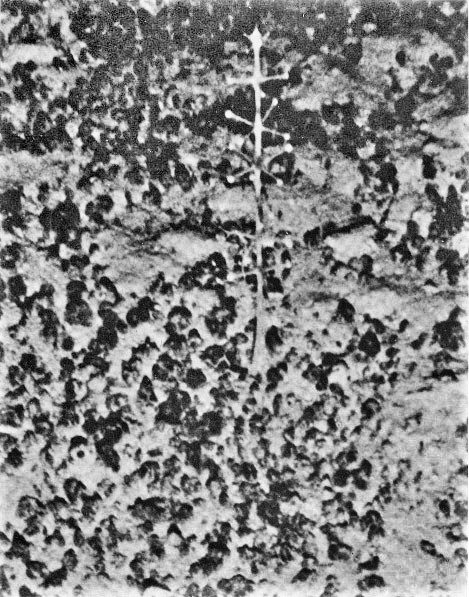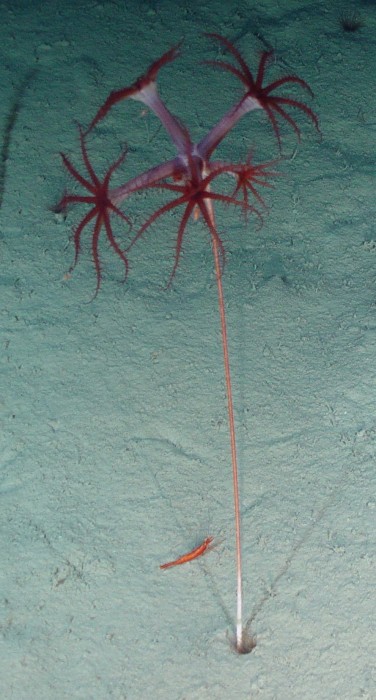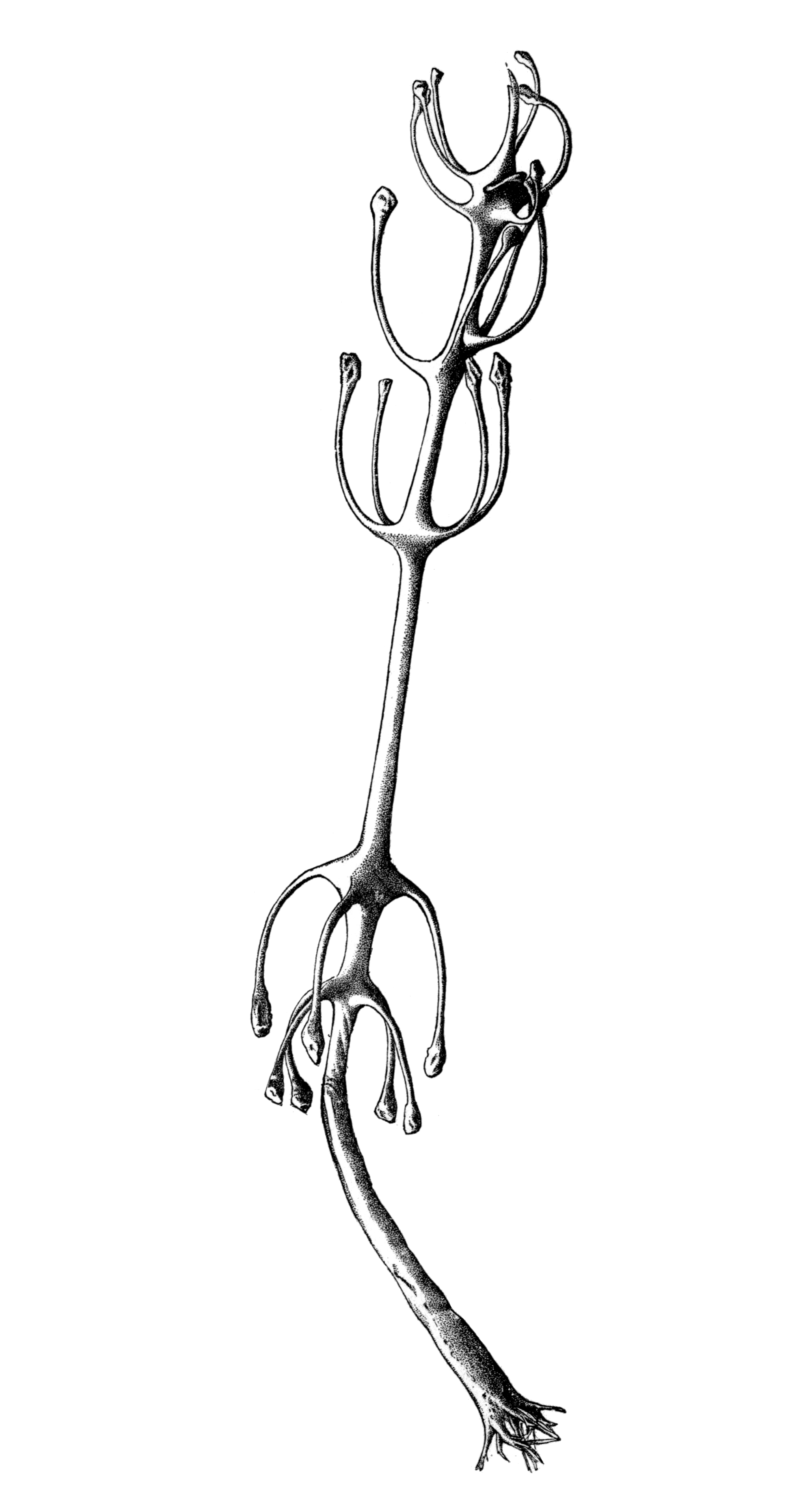1964, August 29: The Eltanin Object
In 1962, the National Science Foundation of the United States had an Antarctic resupply vessel completely re-outfited to become their first floating laboratory, with the purpose of using the ship to explore the coastal waters and oceans surrounding Antarctica. The vessel, the USNS Eltanin, was sent on a series of investigative missions over a four year period covering varying areas of the Antarctic region.
On August 29, 1964, the Eltanin was exploring the ocean areas between 60 and 50 degrees South Latitude on the line at 125 degrees West Longitude... which basically means out in the Pacific Ocean between the southern tips of South America and Australia, towards Antarctica, in an area with no islands at all. The ship was, among other activities, taking pictures of the ocean floor with a camera pulled along by cable from the ship; and sometime during this maneuver, the following picture was taken:

An odd object on the Antarctic sea bed? [Larger version here]
I haven't found any official notes on the photo, so I can't tell you when the picture was first noticed among the untold numbers that had been taken, nor what the crew and scientists on the ship thought at the time. What I do know is that the photo first came to public attention on December 5, 1964, in an article in the New Zealand Herald newspaper.
On December 4, the Eltanin ended it's 15th voyage to the Antarctic by setting to port in Auckland, New Zealand, for a major overhaul and refit before it set out again... and it was at this time that someone from the ship showed the picture to the newspaper. The news article, titled "Puzzle Picture From Sea Bed," didn't say much; It implied a lot, however:
"The American research ship Eltanin sailed into Auckland yesterday with a mysterious photo taken at 2250 fathoms 1000 miles west of Cape Horn.
The photograph, which to a layman shows something like a complex radio aerial jutting out of the mud bottom, was taken on August 29 by a submarine camera."
In the article Dr. Thomas Hopkins, described as the senior marine biologist on the Eltanin, stated that he felt the object could not be a plant because it was too deep down for there to be enough light to support photosynthesis; 2250 fathoms is equivalent to 13,500ft/4115m under the surface, so very deep indeed. The ship's photographer had been questioned extensively, and the scientists on board were quite sure the photo wasn't simply a fake... it was just odd. The object was estimated to be about two feet high.
Hopkins was also quoted as saying “I wouldn’t like to say the thing is man-made because this brings up the problem of how one would get it there ... But it’s fairly symmetrical and the offshoots are all 90 degrees apart. This is why it has been argued over for so long.”
This article apparently never spread out from the New Zealand Herald so, publicly, the story of the strange photo just wasn't a national or international news story. However, between Hopkins' commentary and the initial description in the article of the object as looking like a "complex radio aerial," no one should have been surprised by what came next.
UFOs!
In June 1968, the story of the Eltanin photo turned up in the American adventure magazine SAGA, in an article with the rather telling title of "Unidentified Underwater Saucers." Written by Brad Steiger and Joan Whritenour, the Eltanin object was mentioned as just one of several examples of what the authors felt clearly suggested that the Unidentified Flying Objects (UFOs) being reported worldwide at the time -- and largely assumed to be advanced technology from an alien culture in space -- were also to be found under the surface of the world's oceans.
Steiger and Whritenour start their accounting of the matter from the details of the New Zealand Herald report, reporting the same details for time and place, but placing special emphasis on Hopkins' quote above about looking man-made, saying he was 'evading' pressure to admit the object was some form of technology.
The authors then add something new: "Dr. Hopkins clarified the object's location as being on the 45,000-mile faultline rift that encircles our planet." This detail, which most certainly is not in the New Zealand Herald article, is then taken as the starting point for speculating that the strange 'device' is meant to measure important geodetic and seismic information for the benefits of unknown agency. This unknown agency is then implied to be beyond human capabilities because "our science does not yet possess underwater vehicles capable of descending to such depths; therefore, no one on Earth, that we are aware of, could have placed the device off Cape Horn..." which, of course, ignores the possibility that a device could have been dropped into place, much like the camera that took the picture of the object.
Perhaps the weirdest thing about this new take on the story is one simple choice: while the article has a picture of the USNS Eltanin, the article does not include the actual picture above of the strange object that the article discusses!
The Eltanin story next resurfaced in 1970, in an article in The INFO Journal, a publication produced by the International Fortean Organization, a by-membership organization devoted to the study of odd and paranormal matters. Judging from the short article, the INFO author had seen the SAGA article, and then tracked down the New Zealand Herald newspaper article. The INFO author quickly brushed off the idea that the object was undeniably of alien nature, suggesting instead the possibility that the photo showed an unknown aquatic lifeform, possibly related to an already known creature called Umbellula.

An Umbellula. [Larger version here]
Unfortunately, this logical idea suffered from just one weakness... the INFO Journal was only read by members of the International Fortean Organization, so the possible explanation for the Eltanin object didn't become generally known. And in 1975, Brad Steiger re-printed the SAGA article as a chapter in his book, The Strange World of Brad Steiger. In the years between 1968 and 1975, Steiger had gained an audience who actively hunted out books on paranormal matters by him... so this re-presentation of the story was soon being copied by other 'researchers' on strange topics, and became the most repeated public version of the story.
The Answer...?
By 2003, Steiger's version of the Eltanin story dominated most mentions of the photo in both books and websites worldwide... though most had no idea where they'd gotten the story from, realistically. In addition, and on the assumption that the object was in fact some sort of alien technology antenna, a number of extensive theories had been developed regarding global lines of travel for UFOs, all with the Eltanin 'antenna' as a key point. This year, after an e-zine called UFO Roundup covered the original Eltanin photo story, a number of discussions of the photo developed in online UFO forums... and one of the various researchers -- Larry Hatch -- felt he had discovered the answer to the question of the object's identity.
In his website, Hatch explained that a 1971 book called The Face of the Deep, by Bruce Heezen and Charles Hollister, showed an illustration of a sea sponge that had been discovered in 1888 when a ship called the Blake dredged up a variety of things from the ocean floor for study.

Cladorhiza [Larger version here]
Heezen and Hollister, apparently unaware of the Eltanin affair, described the strange animal thus: "Cladorhiza, a particularly dramatic [sponge] which somewhat resembles a space-age microwave antenna, was not uncommon in the early dredge hauls of Challenger and Blake." The book Three Cruises of the Blake, the 1888 book by Alexander Agassiz from which the illustration was taken, stated "they are sponges with a long stem ending in ramifying roots, sunk deeply into the mud. The stem has nodes with four to six club-like appendages. They evidently cover like bushes extensive tracts of the bottom." Hatch clearly felt that the strange object in the Eltanin photo was just one of these sponges, standing out as especially weird because it was standing alone... if it have been in a large patch full of them, people would have guessed the object was a lifeform of some sort sooner.
Hatch's conclusion -- as well as a summary of the mess the whole Eltanin affair had become -- was printed in an article by Peter Brookesmith in May 2004 in the British magazine Fortean Times, something of a modern successor to the International Fortean Organization's INFO Journal. And Brookesmith's article became the basis of the Wikipedia article on the "Eltanin Antenna," making Hatch's conclusion the official answer for the question of the object's identity to the world.
Of course, things aren't exactly that simple. As recently as 2016, new books were still repeating Steiger's theory of alien technology, so even a Wikipedia article won't stop that story from spreading. And even though the argument that the picture shows a known sponge is attractive, it's still a remarkable thing to get a random picture of a single sponge that usually exists in vast bunches... and what if the object isn't a sponge? How exactly would anyone know? Ultimately, the one action that would have answered all the important questions is now likely too late to help: going back to look again.
Anomalies -- the Strange & Unexplained, as well as my other website -- Monsters Here & There -- are supported by patrons, people like you! All new Anomalies articles are now posted for my patrons only, along with exclusive content made just for them. You can become a patron for just $1 a month!
|








